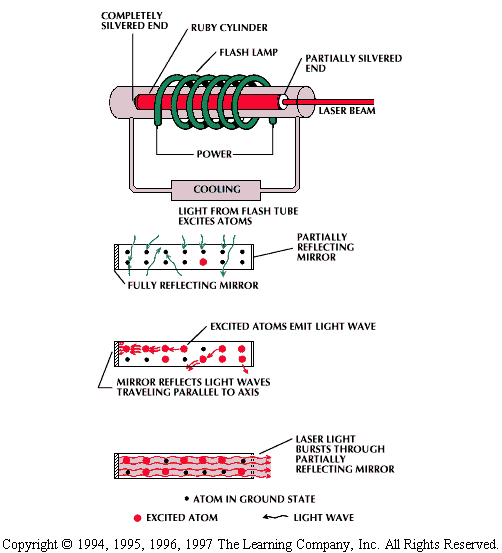
White Light Lasers:
White light lasers produce one single beam. This beam then passes through a prism. Once the light passes through the prism, it is broken into several beams with distinct colors. KAL uses this type of laser because it is more efficient than many others. Instead of only emitting a few colors, we provide our viewers with a wide variety of colors.1
Yag Lasers
Yag lasers are solid state lasers. These lasers use yttrium aluminum garnet as the lasing medium. The color that is emitted through this laser is a bright green color. There is normally a flash lamp that is used to help excite the electrons in this laser.1

http://www.technology.niagarac.on.ca/courses/tech238g/Lasers.html
This is an example of the first set of lasers. It mostly only referred to as a historical laser. It uses a ruby coil, but the main ideas from this laser is what is now used modern day lasers. The HeNE laser is based off of this laser. energy is used to excite the electrons to move from the ground state to a higher valance shell. Then the photons are "bounced" off of a mirror that is coated to make sure it reflects the photons instead of absorbing them. Once the photons are reflected, the excited atoms emit a light wave, which is coherent. These parallel waves are then projected out of the laser device, and used for the laser show.
More Types of Lasers2
| Name | Lasing material | Power range pulsed/cw |
Beam properties, Wavelength | Applications |
| YAG | Nd3+-ions
in host material YAG 4-level |
cw 0.2mW -10W Q-switched 1mJ-1J per pulse |
Good beam quality, 1064nm (IR) also SHG (see ch4) 532nm | Distance measuring,
chemical large-distance analysis, pointer for electronic vision SHG also pointing for human vision |
| Erbium Holmium |
Er3+ and
Ho3+-ions in different host materials (YAG, YLF, glass) 3-level systems |
Q-switched 1mJ-100mJ | Several more or less eye-safe wavelengths between 1.4Ám and 1.9Ám | Not yet fully established commercially, but will replace YAG in many applications where human eyes can be injured (and this is not the purpose) |
| Titanium-sapphire | Ti-ions with sapphire (Al2O3) as host material | Pumped by laser only; you need another laser to pump this one. | Possible to set between 650nm and 1050nm (approximately)) | All applications needing laser with extremely short pulses (.01ps) |
| Ruby | Cr3+-doped
sapphire 3-level system |
Pelsed1mJ to 10J during some ten nanoseconds | 694nm, bad profile of beam, unstable. | Today mostly historical interest. First laser ever built. |
Gas Lasers2
| Name | Lasing material | Power range pulsed/cw |
Beam properties, Wavelength | Applications |
| Helium-Neon | Gas mixture. Helium Absorbs energy from the current and pass it on to Neon. | Only cw 0.2mW-20mW | Very good, often
more than
99%TEM00 633nm |
All-round where the power isn't the issue. Distance measuring, pointer, angular measurements, building and construction, teaching. |
| Argon | Ionized Argon gas | Cw from 10mW to 25W Pulsed (often mode locked, but unusual). Top power in the kW-range |
Good, often
multi-line several (to the eye discernable) wavelengths lasing at the
same time. UV to 514nm |
Measuring greater distances, directional aid (e.g. at airports), holography, entertainment use, measurement of gaseous and liquid flow |
| Helium-Cadmium | As HeNe with Cadmium replacing Ne. | 1mW to 10mW only cw |
Very good. However, the laser costs 5-10 times as much as HeNe. | Same as HeNe, but in applications needing shorter wavelength. |
| Carbon dioxide | Gaseous CO2 | from 10mW up to
25kW (!!!!) cw Also pulsed |
Poor. 10.6Ám; far out in the IR-part of the spectrum. Need to use special optics (often germanium-based) | Due to high
efficiency often for industrial purposes.
Destructive at close range? |
1*- How lasers work. Available Online.
<http://www.technology.niagarac.on.ca/courses/tech238g/Lasers.html >
6 April 2005.
2*- Different Types of Lasers. Available Online.
<www.optics.kth.se/book/ch3/page3/huvudsid3.htm> 5 April 2005.
**This page is not that of a real company, but is for a chemistry assignment for general cehmistry 140 at Monmouth College. **
KAL's home page Back to Laser's main page How Lasers work Fire Works Music